presentation evaluation criteria
- 格式:pdf
- 大小:143.73 KB
- 文档页数:2

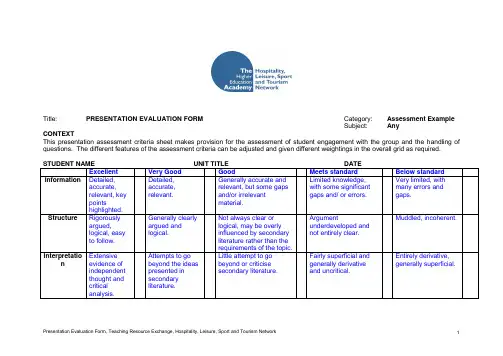
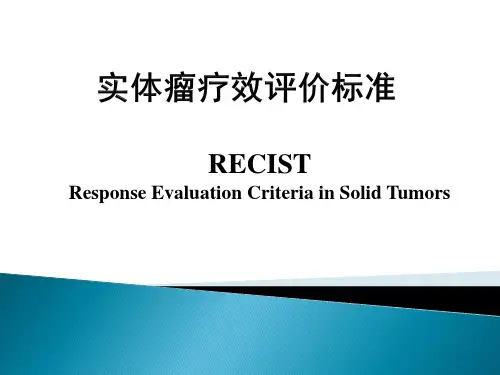
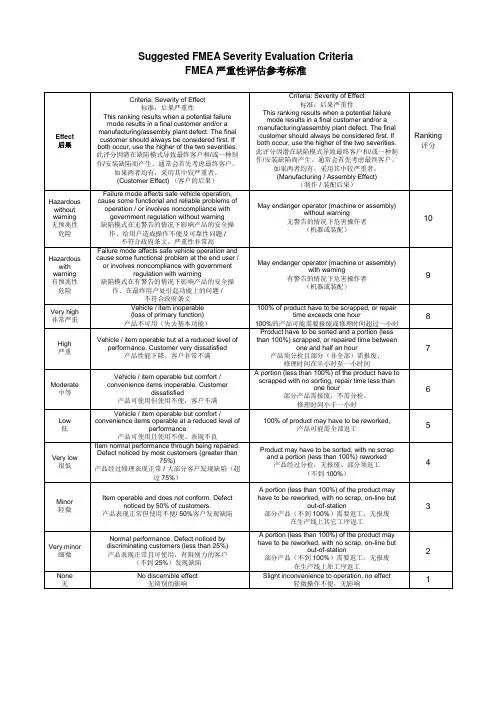
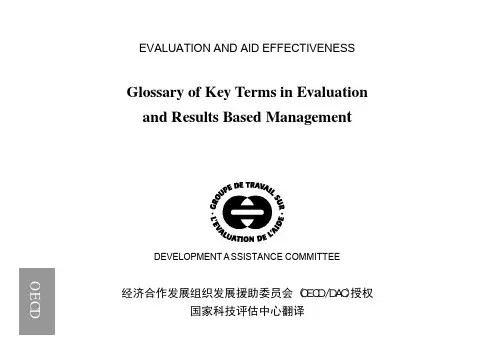
EVALUATION AND AID EFFECTIVENESSGlossary of Key Terms in Evaluationand Results Based Managemen t评估和面向结果管理的关键术语 DEVELOPMENT ASSISTANCE COMMITTEE Array经济合作发展组织发展援助委员会(OECD/DAC)授权 国家科技评估中心翻译Glossaire 关键术语GLOSSARY OF KEY TERMS IN EVALUATIONAND RESULTS BASED MANAGEMENT评估和面向结果管理的关键术语1Glossaire 关键术语FOREWORDThe DAC Working Party on Aid Evaluation (WP-EV) has developed this glossary of key terms in evaluation and results-based management because of the need to clarify concepts and to reduce the terminological confusion frequently encountered in these areas. Evaluation is a field where development partners – often with widely differing linguistic backgrounds – work together and need to use a common vocabulary. Over the years, however, definitions evolved in such a way that they bristled with faux ami s, ambivalence and ambiguity. It had become urgent to clarify and refine the language employed and to give it a harmonious, common basis. With this publication, the WP-EV hopes to facilitate and improve dialogue and understanding amo ng all those who are involved in development activities and their evaluation, whether in partner countries, development agencies and banks, or non-governmental organisations. It should serve as a valuable reference guide in evaluation training and in practical development work.The selection of terms and their definitions in the attached glossary have been carefully discussed and analysed and have benefited from advice and inputs, notably from DAC Members and the academic evaluation community. A WP-EV Task Force, chaired by the World Bank, led the overall project, in collaboration with the Secretariat. France took the lead on the French version, whilst the Inter-American Development Bank produced the Spanish translation. Denmark, the Netherlands, Norway, and UNDP provided financial support for the initial collection and review work, and Switzerland contributed financial support for producing this free distribution publication.The process has been guided by the highest considerations of clarity and conciseness and a spirit of collaboration and compromise in terms of the willingness of major development agencies and banks not to impose their specific vocabulary on others. Although terminology will continue to evolve alongside changing development practices and management instruments, this glossary is a “state-of- the-art” of key terms in use today.Niels DabelsteinChair of the Working Party on Aid Evaluation.2Glossaire 关键术语前言 这份术语表包含了关于评估和面向结果的管理的关键术语。

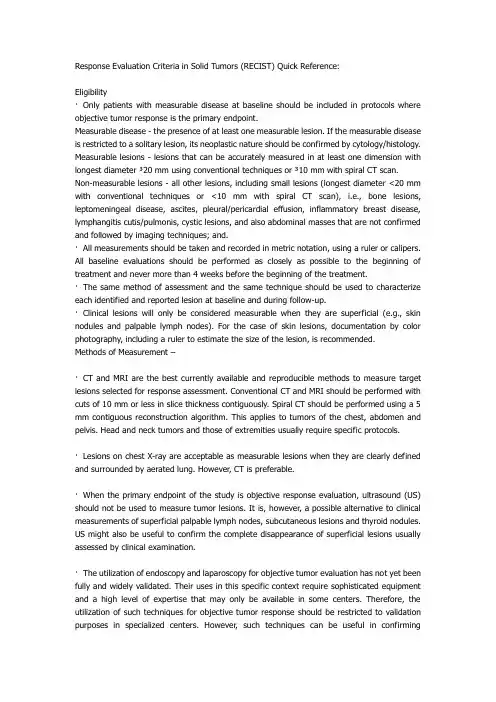
Response Evaluation Criteria in Solid Tumors (RECIST) Quick Reference:Eligibility· Only patients with measurable disease at baseline should be included in protocols where objective tumor response is the primary endpoint.Measurable disease - the presence of at least one measurable lesion. If the measurable disease is restricted to a solitary lesion, its neoplastic nature should be confirmed by cytology/histology. Measurable lesions - lesions that can be accurately measured in at least one dimension with longest diameter ³20 mm using conventional techniques or ³10 mm with spiral CT scan.Non-measurable lesions - all other lesions, including small lesions (longest diameter <20 mm with conventional techniques or <10 mm with spiral CT scan), i.e., bone lesions, leptomeningeal disease, ascites, pleural/pericardial effusion, inflammatory breast disease, lymphangitis cutis/pulmonis, cystic lesions, and also abdominal masses that are not confirmed and followed by imaging techniques; and.· All measurements should be taken and recorded in metric notation, using a ruler or calipers. All baseline evaluations should be performed as closely as possible to the beginning of treatment and never more than 4 weeks before the beginning of the treatment.· The same method of assessment and the same technique should be used to characterize each identified and reported lesion at baseline and during follow-up.· Clinical lesions will only be considered measurable when they are superficial (e.g., skin nodules and palpable lymph nodes). For the case of skin lesions, documentation by color photography, including a ruler to estimate the size of the lesion, is recommended.Methods of Measurement –· CT and MRI are the best currently available and reproducible methods to measure target lesions selected for response assessment. Conventional CT and MRI should be performed with cuts of 10 mm or less in slice thickness contiguously. Spiral CT should be performed using a 5 mm contiguous reconstruction algorithm. This applies to tumors of the chest, abdomen and pelvis. Head and neck tumors and those of extremities usually require specific protocols.· Lesions on chest X-ray are acceptable as measurable lesions when they are clearly defined and surrounded by aerated lung. However, CT is preferable.· When the primary endpoint of the study is objective response evaluation, ultrasound (US) should not be used to measure tumor lesions. It is, however, a possible alternative to clinical measurements of superficial palpable lymph nodes, subcutaneous lesions and thyroid nodules. US might also be useful to confirm the complete disappearance of superficial lesions usually assessed by clinical examination.· The utilization of endoscopy and laparoscopy for objective tumor evaluation has not yet been fully and widely validated. Their uses in this specific context require sophisticated equipment and a high level of expertise that may only be available in some centers. Therefore, the utilization of such techniques for objective tumor response should be restricted to validation purposes in specialized centers. However, such techniques can be useful in confirmingcomplete pathological response when biopsies are obtained.· Tumor markers alone cannot be used to assess response. If markers are initially above the upper normal limit, they must normalize for a patient to be considered in complete clinical response when all lesions have disappeared.· Cytology and histology can be used to differentiate between PR and CR in rare cases (e.g., after treatment to differentiate between residual benign lesions and residual malignant lesions in tumor types such as germ cell tumors).Baseline documentation of “Target” and “Non-Target” lesions· All measurable lesions up to a maximum of five lesions per organ and 10 lesions in total, representative of all involved organs should be identified as target lesions and recorded and measured at baseline.· Target lesions should be selected on the basis of their size (lesions with the longest diameter) and their suitability for accurate repeated measurements (either by imaging techniques or clinically).· A sum of the longest diameter (LD) for all target lesions will be calculated and reported as the baseline sum LD. The baseline sum LD will be used as reference by which to characterize the objective tumor.· All other lesions (or sites of disease) should be identified as non-target lesions and should also be recorded at baseline. Measurements of these lesions are not required, but the presence or absence of each should be noted throughout follow-up.Response CriteriaEvaluation of target lesions* Complete Response (CR): Disappearance of all target lesions* Partial Response (PR): At least a 30% decrease in the sum of the LD of target lesions, taking as reference the baseline sum LD* Progressive Disease (PD): At least a 20% increase in the sum of the LD of target lesions, taking as reference the smallest sum LD recorded since the treatment started or the appearance of one or more new lesions* Stable Disease (SD): Neither sufficient shrinkage to qualify for PR nor sufficient increase to qualify for PD, taking as reference the smallest sum LD since the treatment started Evaluation of non-target lesions* Complete Response (CR): Disappearance of all non-target lesions and normalization of tumor marker level* Incomplete Response/ Stable Disease (SD): Persistence of one or more non-targetlesion or/and maintenance of tumor marker level above the normal limits* Progressive Disease (PD): Appearance of one or more new lesions and/or unequivocal progression of existing non-target lesions (1)(1) Although a clear progression of “non target” lesions only is exception al, in such circumstances, the opinion of the treating physician should prevail and the progression status should be confirmed later on by the review panel (or study chair).Evaluation of best overall responseThe best overall response is the best response recorded from the start of the treatment until disease progression/recurrence (taking as reference for PD the smallest measurements recorded since the treatment started). In general, the patient's best response assignment will depend on the achievement of both measurement and confirmation criteriaTarget lesions Non-Target lesions New Lesions Overall responseCR CR No CRCR Incomplete response/SD No PRPR Non-PD No PRSD Non-PD No SDPD Any Yes or No PDAny PD Yes or No PDAny Any Yes PD· Patients with a global deterioration of health status requiring discontinuation of treatment without objective evidence of disease progression at that time should be classified as having “symptomatic deterioration”. Every effort should be made to document the objective progression even after discontinuation of treatment.· In some circumstances it may be difficult to distinguish residual disease from normal tissue. When the evaluation of complete response depends on this determination, it is recommended that the residual lesion be investigated (fine needle aspirate/biopsy) to confirm the complete response status.Confirmation· The main goal of confirmation of objective response is to avoid overestimating the response rate observed. In cases where confirmation of response is not feasible, it should be made clear when reporting the outcome of such studies that the responses are not confirmed.· To be assigned a status of PR or CR, changes in tumor measurements must be confirmed by repeat assessments that should be performed no less than 4 weeks after the criteria for response are first met. Longer intervals as determined by the study protocol may also be appropriate.· In the case of SD, follow-up measurements must have met the SD criteria at least once after study entry at a minimum interval (in general, not less than 6-8 weeks) that is defined in the study protocolDuration of overall response· The duration of overall response is measured from the time measurement criteria are met for CR or PR (whichever status is recorded first) until the first date that recurrence or PD is objectively documented, taking as reference for PD the smallest measurements recorded since the treatment started.Duration of stable disease· SD is measured from the start of the treatment until the criteria for disease progression aremet, taking as reference the smallest measurements recorded since the treatment started. · The clinical relevance of the duration of SD varies for different tumor types and grades. Therefore, it is highly recommended that the protocol specify the minimal time interval required between two measurements for determination of SD. This time interval should take into account the expected clinical benefit that such a status may bring to the population under study. Response review· For trials where the response rate is the primary endpoint it is strongly recommended that allresponses be reviewed by an expert independent of the study at the study’s completion.Simultaneous review of the patients’ files and radiological images is the best approach. Reporting of results· All patients included in the study must be assessed for response to treatment, even if there are major protocol treatment deviations or if they are ineligible. Each patient will be assigned one of the following categories: 1) complete response, 2) partial response, 3) stable disease, 4) progressive disease, 5) early death from malignant disease, 6) early death from toxicity, 7) early death because of other cause, or 9) unknown (not assessable, insufficient data).· All of the patients who met the eligibility criteria should be included in the main analysis of the response rate. Patients in response categories 4-9 should be considered as failing to respond to treatment (disease progression). Thus, an incorrect treatment schedule or drug administration does not result in exclusion from the analysis of the response rate. Precise definitions for categories 4-9 will be protocol specific.· All conclusions should be based on all eligible patients.· Subanalyses may then be performed on the basis of a subset of patients, excluding those for whom major protocol deviations have been identified (e.g., early death due to other reasons, early discontinuation of treatment, major protocol violations, etc.). However, these subanalyses may not serve as the basis for drawing conclusions concerning treatment efficacy, and the reasons for excluding patients from the analysis should be clearly reported.· The 95% confidence intervals should be provided.RECIST (肿瘤疗效评价标准) 快速参考筛选条件:l 当客观肿瘤疗效是评价的主要终点时,只有在基线有可测量疾病的人可以包含到试验方案中。
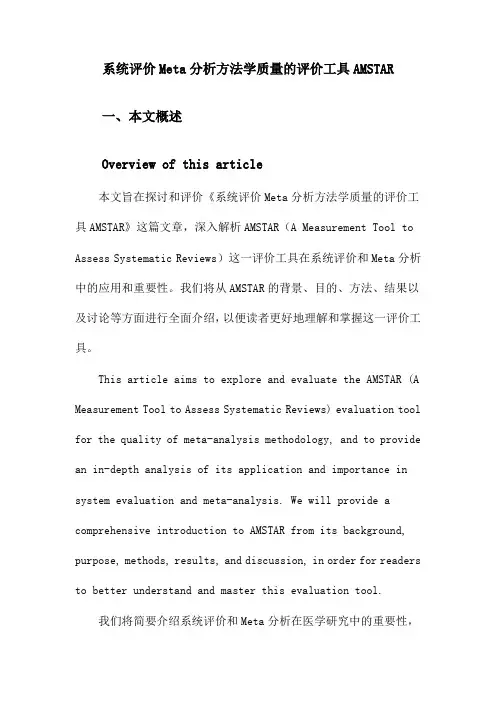
系统评价Meta分析方法学质量的评价工具AMSTAR一、本文概述Overview of this article本文旨在探讨和评价《系统评价Meta分析方法学质量的评价工具AMSTAR》这篇文章,深入解析AMSTAR(A Measurement Tool to Assess Systematic Reviews)这一评价工具在系统评价和Meta分析中的应用和重要性。
我们将从AMSTAR的背景、目的、方法、结果以及讨论等方面进行全面介绍,以便读者更好地理解和掌握这一评价工具。
This article aims to explore and evaluate the AMSTAR (A Measurement Tool to Assess Systematic Reviews) evaluation tool for the quality of meta-analysis methodology, and to provide an in-depth analysis of its application and importance in system evaluation and meta-analysis. We will provide a comprehensive introduction to AMSTAR from its background, purpose, methods, results, and discussion, in order for readers to better understand and master this evaluation tool.我们将简要介绍系统评价和Meta分析在医学研究中的重要性,以及为什么需要对这些方法学质量进行评价。
接着,我们将详细介绍AMSTAR的发展背景、理论基础和构建过程,以便读者了解该评价工具的起源和依据。
We will briefly introduce the importance of system evaluation and meta-analysis in medical research, as well as why it is necessary to evaluate the quality of these methodologies. Next, we will provide a detailed introduction to the development background, theoretical basis, and construction process of AMSTAR, so that readers can understand the origin and basis of this evaluation tool.在方法部分,我们将详细介绍AMSTAR的具体内容、评分标准和评价方法,包括各个条目的定义、评分依据以及如何运用AMSTAR对系统评价和Meta分析进行质量评价。

计算机网络管理员理论参考题库(答案附后)一、单项选择题(每小题有A、B、C、D四个选项,只有一个选项符合题目要求)1.只有支持HTTP1.1协议标准的“放置”功能,浏览器才能执行( )操作。
A.读取B.写入C.目录浏览D.索引资源2.以太网交换机通过( )地址表来跟踪连接到交换机的各个结点的位置。
A.IPB.MACC.DNS服务器D.网关3.制订安全策略的内容不包括( )。
A.确定用户的权利和责任B.确定系统管理员的权利和责任C.确定数据资源不被计算机病毒破坏D.确定网络信息的可用性4.网卡故障后有两类基本的表现。
一类是( ),即不再进行正常的网络通信并且不再向网络发送任何数据,对网络基本上没有破坏性。
另一类是“狂躁型”,发生故障后向网络发送不受限制的数据包,对网络性能造成严重影响甚至破坏。
A.“狂热型”B. “安静型”C. “静止型”D. “安稳型”5.使用下列( )用户组的成员登录,可以创建新的用户组。
A.Replicator组、Guests组B.Power Users组、Replicator组C.Administrators组、Administrators组D.Power Users组、Guests组6.下列选项( )不属于《中华人民共和国著作权法》中所指的作品。
A.通用公式B.杂技作品C.口述的作品D.地图、示意图等图形作品7.下列选项中属于企业文化功能的是( )。
A.体育锻炼B.整合功能C.歌舞娱乐D.社会交际8.关于路由器接口状态和线路协议状态都为down的原因,下列正确的是( )。
A.在一个背对背的连接中,另一端的设备正处于管理性关闭状态B.没有设置时钟速率C.数据封装类型不匹配等问题D.没有保存信号9.Exchange Server服务器支持IE(3.02以上的版本)需要在服务器的( )中做好相应设置。
A.IIS管理器B.ACCESSC.System ManageD.Outlook10.计算机机房的构造、装修必须严格遵守有关消防规定,如建筑耐火等级( )。
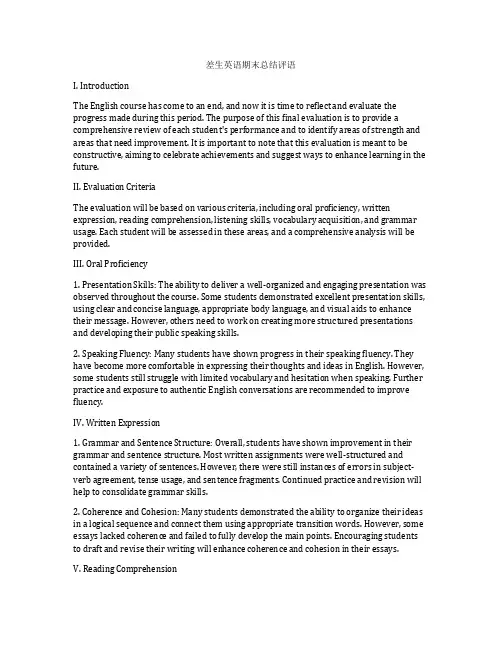
差生英语期末总结评语I. IntroductionThe English course has come to an end, and now it is time to reflect and evaluate the progress made during this period. The purpose of this final evaluation is to provide a comprehensive review of each student's performance and to identify areas of strength and areas that need improvement. It is important to note that this evaluation is meant to be constructive, aiming to celebrate achievements and suggest ways to enhance learning in the future.II. Evaluation CriteriaThe evaluation will be based on various criteria, including oral proficiency, written expression, reading comprehension, listening skills, vocabulary acquisition, and grammar usage. Each student will be assessed in these areas, and a comprehensive analysis will be provided.III. Oral Proficiency1. Presentation Skills: The ability to deliver a well-organized and engaging presentation was observed throughout the course. Some students demonstrated excellent presentation skills, using clear and concise language, appropriate body language, and visual aids to enhance their message. However, others need to work on creating more structured presentations and developing their public speaking skills.2. Speaking Fluency: Many students have shown progress in their speaking fluency. They have become more comfortable in expressing their thoughts and ideas in English. However, some students still struggle with limited vocabulary and hesitation when speaking. Further practice and exposure to authentic English conversations are recommended to improve fluency.IV. Written Expression1. Grammar and Sentence Structure: Overall, students have shown improvement in their grammar and sentence structure. Most written assignments were well-structured and contained a variety of sentences. However, there were still instances of errors in subject-verb agreement, tense usage, and sentence fragments. Continued practice and revision will help to consolidate grammar skills.2. Coherence and Cohesion: Many students demonstrated the ability to organize their ideas in a logical sequence and connect them using appropriate transition words. However, some essays lacked coherence and failed to fully develop the main points. Encouraging students to draft and revise their writing will enhance coherence and cohesion in their essays.V. Reading Comprehension1. Reading Speed and Accuracy: Most students displayed satisfactory reading speed and accuracy. They were able to comprehend the main ideas and details of the texts assigned during the course. However, there were a few students who struggled with reading speed, which affected their overall comprehension. Regular reading practice, both inside and outside the classroom, will help improve reading fluency.2. Inference and Interpretation: Many students demonstrated the ability to make inferences and draw conclusions from the texts. They were able to identify the author's purpose, point of view, and supporting evidence. However, some students need further practice in analyzing texts and understanding implied meanings.VI. Listening Skills1. Listening Comprehension: Students generally exhibited satisfactory listening comprehension skills. They were able to understand the main ideas, details, and specific information from the listening materials used in class. However, a few students struggled to understand certain accents or rapid speech. Encouraging students to engage in listening activities with authentic English materials will improve their listening skills.2. Note-Taking: Most students demonstrated good note-taking skills during lectures and audio recordings. They were able to capture key points and important details. However, there is still room for improvement in organizing notes and effectively using them in subsequent tasks.VII. Vocabulary Acquisition1. Vocabulary Expansion: Students have shown progress in expanding their vocabulary. They were able to use a wide range of words and phrases in their speaking and writing. However, some students need more exposure to authentic English texts and contexts to further enrich their vocabulary.2. Word Usage: Overall, students demonstrated appropriate word usage in their speaking and writing. However, there were instances of improper word choices and incorrect collocations. Encouraging students to regularly use new words in different contexts will enhance their word usage skills.VIII. ConclusionIn conclusion, the English course has provided an opportunity for students to develop their English language skills in various areas. Most students have made commendable progress in their oral proficiency, written expression, reading comprehension, listening skills, vocabulary acquisition, and grammar usage. However, there are still areas that need improvement, such as presentation skills, speaking fluency, coherence and cohesion in writing, reading speed, inference and interpretation, listening skills, note-taking, and word usage. It is recommended that students continue practicing English in authentic contexts, engage in regular reading and listening activities, and seek opportunities to communicate inEnglish with native speakers or language exchange partners. With perseverance and consistent effort, further improvement can be achieved in the future.。

高中英语教学评一体化教学理念与策略以下是为您生成的关于高中英语“教学评一体化教学理念与策略”相关的英语释义、短语、单词、用法和双语例句,一共二十个:---1. 教学评一体化(Integration of Teaching, Learning and Assessment)- 英语释义:The combination and integration of teaching methods, students' learning processes, and assessment systems to achieve an effective educational outcome.- 短语:achieve integration of teaching, learning and assessment(实现教学评一体化)- 单词:integration(整合,一体化)- 用法:“The school is committed to the integration of teaching, learning and assessment.”(这所学校致力于教学评一体化。
) - 双语例句:教学评一体化有助于提高教学质量。
The integration of teaching, learning and assessment helps improve the teaching quality.2. 以学生为中心(Student-centered)- 英语释义:An educational approach that focuses on the needs, interests, and abilities of students.- 短语:student-centered teaching method(以学生为中心的教学方法)- 单词:centered(以...为中心的)- 用法:“We should adopt a student-centered approach in our teach ing.”(我们在教学中应该采用以学生为中心的方法。
XXX有限公司质量管理体系程序文件风险和机遇识别应对控制程序(中英文版)Risk and opportunity recognition control program风险和机遇识别应对控制程序Risk and opportunity recognition control program1、目的 purpose为建立风险和机遇的应对措施,明确包括风险应对措施风险规避、风险降低和风险接受在内的操作要求,建立全面的风险和机遇管理措施和内部控制的建设,增强抗风险能力,并为在质量管理体系中纳入和应用这些措施及评价这些措施的有效性提供操作指导。
In order to establish the risk and opportunity response measures, including risk management measures, risk reduction and risk acceptance, the operational requirements, including risk avoidance, risk reduction and risk acceptance, should be clearly defined, and comprehensive risk and opportunity management measures and internal control should be established. Enhance risk tolerance and provide operational guidance for incorporating and applying these measures and evaluating their effectiveness in the quality management system.2、范围 Scope本程序适用于在公司质量管理体系活动中应对风险和机遇的方法及要求的控制提供操作依据,这些活动包括:This procedure applies to the control of methods and requirements to address risks and opportunities in the quality management system activities of the company. These activities include:1)业务开发、市场调查及客户满意度测评过程的风险和机遇管理;Risk and opportunity management in business development, market research and customer satisfaction assessment process;2)产品的设计开发、设计开发的变更控制过程的风险和机遇管理;Product design and development, design and development of change control process risk and opportunity management;3)供应商评审和采购控制过程的风险和机遇管理;Risk and opportunity management of supplier review and procurement control process;4)生产过程的风险和机遇管理;Risk and opportunity management in the process of production;5)过程检验和监视测量设备的管理过程的风险和机遇管理;Process inspection and monitoring measurement equipment management process risk and opportunity management;6)设备和工装夹具的维护和保养管理过程的风险和机遇管理;Risk and opportunity management of equipment and fixture maintenance and maintenance process;7)不合格品的处置及纠正预防措施的执行和验证过程的风险和机遇管理;Management of risks and opportunities in the handling of nonconforming products and the implementation of corrective and preventive actions and verification process;8)持续改进过程的风险和机遇管理; Risk and opportunity management of continuous improvement process;9)当适用时,也可适用于对公司管理过程中应对风险和机遇的控制提供操作指南。
常见专业术语:组织过程定义控制程序process for organizational process definition 软件生命周期模型software life cycle model组织标准过程集合描述description of organization's set of standard process.组织标准过程裁剪指南tailoring guideline for organizational standard process过程数据库使用规范usage specification for process metrics library过程财富度量报告measurement report for process asserts项目生命周期模型选择工作单sheet for selecting project software lifecycle model组织过程焦点控制程序process for organizational process focus EPG工作章程EPG charterEPG工作考核细则performance appraisal rules for EPG member过程改进建议处理控制程序process for handling process improvement proposal过程定义文件配置管理规范configuration management specification for process definition document过程行动组(PAT)工作记录process action team (PAT) working record过程定义文件试验结果评定表evaluation form for pilot result of process definition document过程状态季度报告模板process status quarterly report template过程行动计划process action plan过程推广计划process promotion plan过程试验计划process pilot plan公司年度过程评估计划organizational process assessment annual plan 公司过程改进总体要求 General objectives for organizational process improvement会议记录meeting minutes过程改进建议和意见汇总表summary form of comments and suggestions of PI过程改进实践状态清单 status list for process improvement practice EPG工作度量epg metrics程序文件评审讨论问题记录表issue record of process document review过程改进总体计划General plan for process improvement过程改进工作度量报告 metrics report for process improvement过程豁免申请单 process exempt application过程改进任务列表 process improvement tasks list组织级培训过程控制程序organization- level training process兼职讲师管理规定part-time instructor management regulation 免修规程training waiver procedure培训课程开发规程training course development procedure外购培训管理规程outsourcing training management procedure培训效果评估规定training effectiveness evaluation procedure 培训效果跟踪表 training effectiveness tracking record员工培训计划申请表application for employee training plan员工外训学习申请表application for employee external training 免修培训申请表application for training waiver战略培训需求表demands form for strategic training需求管理控制程序requirement management process需求变更控制规程requirement change control procedure变更影响分析控制规程 Impact analysis procedure of change确定项目已定义过程规程procedure for establishing project's defined process项目协调与沟通规程project communication & negotiation procedure 风险管理控制程序risk management process风险管理指导书risk management guidebook风险管理计划risk management plan风险列表risk list商业现货软件产品选择控制程序COTS product selection process COTS软件产品评价准则COTS product evaluation criteriaCOTS软件产品评价报告COTS product evaluation report供应商合作通知单cooperation notification to supplier第三方产品评估表the 3rd party's product evaluation form商业现货采购控制程序 COTS product procurement process软件子合同管理控制程序software sub-contract management process子合同评审规程sub-contract review procedure子合同开发监管规程sub-contract development monitoring procedure子合同配置管理规程sub-contract Configuration Management procedure子合同配置监督计划模版sub-contract configuration monitoring plan template子合同QA审核规程sub-contract QA audit procedure软件子承包商评定标准 sub-contractor evaluation criteria直真软件开发子合同模板(商务) contract template (business) for ZZ's software sub-contract子合同开发过程监控报告sub-contract development monitoring report子合同开发过程监控计划sub-contract development monitoring plan子合同工作计划sub-contract working plan产品(项目)子合同申请单application form for product( project ) sub-contract候选子承包商评估报告 candidate sub-contractor evaluation report 软件子合同评审记录software sub-contract review record项目策划控制程序project planning process规模估计规程size estimation procedure工作量估计规程effort estimation procedure编制进度规程schedule generation procedure项目策划计划plan for project planningPDSP文档PDSP document项目环境列表project's environment list项目的任务WBS列表project's task WBS list产品规模估计表product size estimation form工作量估计表effort estimation form关键计算机资源表CCR list外来工作产品清单out-sourcing work product list主要工作产品清单main work product list交付工作产品清单deliverable work product list人力资源需求表HR demands form人力资源评估表HR evaluation form项目人员计划表project's HR plan项目预算工时表project's budget/ effort form项目需增加硬件、软件成本预算表Budget form for hardware & software added共利益者协调计划表stakeholder negotiation plan资料管理计划表materials management plan开发计划development plan项目培训计划project training plan项目进度表project schedule项目总体进度表abstract project schedule合同项目立项报告initiating report for contract project研发项目立项报告initiating report for R&D project项目跟踪监控程序SPTO process研发中心例会管理规定 Review meeting procedure for R&D center研发项目组例会管理规定Review meeting procedure for R&D project team项目关闭控制程序project closure process里程碑评审规程milestone review procedure软件开发计划变更规程 Software development plan revise procedure 对外承诺变更控制规程 External commitment change procedure测量与分析控制程序 measurement & analysis process度量项定义规程measurement item definition procedure测量目标选择表measurement goal selection list项目测量数据集合project's metrics set项目度量周报project's metrics weekly report测量规格说明书metrics specification度量报告metrics report项目度量计划project's measurement plan决策分析与解决方案控制程序discussion analysis and resolution processDAR运用指南DAR practice guideline决策方案评价准则desiccation resolution evaluation criteria 过程与产品质量保证控制程序process& product quality assurance process不符合问题处理规程non-compliance issue handle procedure项目过程活动评审规程 project's process activity review procedure 项目工作产品审核规程 project's work product audit procedure质量保证活动策划规程 SQA planning procedure不符合问题等级标准non-compliance issue grade standard评价工作产品任务集合 work product evaluation tasks set评价过程活动任务集合 process activity evaluation tasks set不符合问题报告表non-compliance issue report不符合问题跟踪记录表 non-compliance issue tracking record工作产品审核记录表work product audit record过程活动评审记录表process activity review record项目QA计划进度表project's QA planned schedule 外部专家审核报告external expert audit report跨项目QA报告QA report across projects项目QA报告project QA report项目QA计划project QA plan软件配置管理控制程序 software configuration management process配置管理标准configuration management standard测试阶段CI变更规程CI change procedure in testing phase产品出库规程product check-out procedure产品入库规程product check-in procedure产品发布管理规程product release management procedure产品日常备份规程product daily backup procedure配置变更分析规程configuration change impact analysis procedure配置变更管理子过程configuration change management sub-process 配置审核管理规程configuration audit management procedure产品库管理规程product library management procedure配置项状态报告CI status report功能配置审核报告模板 FCA report template物理配置审核报告模板 FCA report template基线配置审核报告模板 baseline configuration audit report template 软件送测单delivering software to testing form日常备份记录daily backup record配置项清单CI list产品发布通知product release notification产品发布报告product release report配置管理计划模版CM plan template配置管理任务列表CM tasks list配置审核问题跟踪记录表configuration audit issues tracking record文件归档申请单application form for document archiving项目SCM任务单project's SCM task list最终产品规模测量记录final product size metrics record销售管理控制程序sales management control process售前支持控制程序pre-sales support control process售前技术支持计划pre-sales technical support plan售前技术申请pre-sales technical application产品定义过程控制程序 product definition process需求调研规程requirement investigation procedure软件需求分析控制程序 software requirement analysis process面向对象需求分析规程 O-O requirement analysis procedure需求分析方法工具指南 guideline for methods /tools of requirement analysis需求缺陷分类标准standard of requirement defect types需求规格说明Checklist checklist for requirement specification需求分析计划跟踪表requirement analysis plan and tracking record 需求不一致项跟踪记录表requirement defect tracking record 产品(产品构件)需求product ( product component) requirement产品(产品构件)需求规格说明书-By Object product ( product component) requirement specification template -by object产品(产品构件)需求规格说明书-By Feature product ( productcomponent) requirement specification template -by feature产品(产品构件)需求规格说明书-By User Class product( product component) requirement specification template -by user class产品(产品构件)需求规格说明书-By Fun Hierarchy product( product component) requirement specification template -by Fun Hierarchy软件概要设计控制程序 software preliminary design process软件详细设计控制程序 software detailed design process概要设计说明书模板一(面向对象) PD document template (OO)概要设计说明书模板PD document template软件开发计划模版SDP template数据库设计说明书模板 database design document template用户界面设计说明书user interface design document详细设计说明书模板DD document template产品实现控制程序-代码实现product realization process-coding设计问题跟踪记录表tracking record for design issuesC++编码规范C++ coding specificationJAVA编程规范JAVA coding specification产品构件实现清单product component realization list产品构件实现方法和计划product component realization method and plan产品实现控制程序-支持文档实现product realization process- supportive document realization产品集成控制程序product integration process接口管理规程interface management procedure集成产品评价规程integrated product evaluation procedure《产品集成策略》模版 product integration strategy template《产品集成评价报告》模版product integration evaluation report template接口跟踪表interface tracking record接口不一致项列表interface non-compliance list部件测试控制程序component testing process产品集成测试控制程序product integration testing process系统测试控制程序system testing processFIRST OFF测试控制程序FIRST OFF testing processBUG管理系统使用规范bug management system usage specification BUG确认规程Bug confirmation procedure正式评审规程formal review procedure同级评审指导书PR guidebook技术评审规程technical review procedure同级评审策划规程PR planning procedure正式评审申请表formal review application技术评审申请表technical review application评审工作分析报告review analysis report评审工作表review working form评审准备数据表review preparation metric form同级评审计划PR plan评审记录和缺陷跟踪表 review record and defect tracking record系统测试数据和测试环境设计system testing metrics and testing environment design部件测试数据和测试环境设计component testing metrics and testing environment design部件测试用例component testing use-case系统测试用例system testing use-case系统测试方案system testing scheme部件测试方案component testing scheme接受系统测试检查单 system testing checklist接受产品集成测试检查单 product integration testing checklist接受部件测试检查单 component testing checklist接受First off测试检查单 FIRST OFF testing checklistFirst off测试计划Fist Off testing plan测试计划testing plan产品集成测试计划product integration testing plan测试问题记录表testing issue record单个自由产品测试总结 independent product testing summary测试报告testing report测试总结testing summary产品集成测试报告product integration testing report代码走查规程code walk-through procedure单元测试规程unit testing procedure制定确认策划规程validation planning procedure确认规程validation procedure需求确认方法描述requirement validation methods description 产品确认方法描述product validation methods description确认计划书模板validation plan template产品验收控制程序product acceptance processFIRST OFF规程Fist off procedure产品发布规程product release procedure产品移交规程product delivery procedure系统集成控制程序system integration process系统集成项目测试验收规程acceptance procedure for system integration project testing系统集成项目维护规程 maintenance procedure for system integration project售后服务控制程序post-sales service control process客户服务请求处理表handle form for customer service application 客户服务请求解决情况统计表statistics for closure status of customer service application客户满意度调查表customer satisfaction questionnaire客户满意度统计分析报告statistics analysis report for customer satisfaction客户满意改进方案customer satisfaction improvement plan售后客户档案(原有文件) post-sales customer profile ( original documents)维护项目控制程序maintenance project control process一级维护任务单the 1st level maintenance tasks form维护项目立项报告initiating report for maintenance project 维护项目工作计划working plan for maintenance project现场服务记录on-site service record现场培训记录on-site training record维护项目总结报告summary report for maintenance project二级任务单the 2nd tasks form项目结束通知单project closure notification项目决算报告project settlement report软件维护控制程序software maintenance control process维护需求记录表maintenance demands record软件维护申请表software maintenance application软件维护记录单software maintenance formAcceptance Testing--可接受性测试一般由用户/客户进行的确认是否可以接受一个产品的验证性测试. actual outcome--实际结果被测对象在特定的条件下实际产生的结果.Ad Hoc Testing--随机测试测试人员通过随机的尝试系统的功能,试图使系统中断.algorithm--算法(1)一个定义好的有限规则集,用于在有限步骤内解决一个问题;(2)执行一个特定任务的任何操作序列.algorithm analysis--算法分析一个软件的验证确认任务,用于保证选择的算法是正确的、合适的和稳定的,并且满足所有精确性、规模和时间方面的要求.Alpha Testing--Alpha测试由选定的用户进行的产品早期性测试.这个测试一般在可控制的环境下进行的.analysis--分析(1)分解到一些原子部分或基本原则,以便确定整体的特性;(2)一个推理的过程,显示一个特定的结果是假设前提的结果;(3)一个问题的方法研究,并且问题被分解为一些小的相关单元作进一步详细研究.anomaly--异常在文档或软件操作中观察到的任何与期望违背的结果.application software--应用软件满足特定需要的软件.architecture--构架一个系统或组件的组织结构.ASQ--自动化软件质量(Automated Software Quality)使用软件工具来提高软件的质量.assertion--断言指定一个程序必须已经存在的状态的一个逻辑表达式,或者一组程序变量在程序执行期间的某个点上必须满足的条件.assertion checking--断言检查用户在程序中嵌入的断言的检查.audit--审计一个或一组工作产品的独立检查以评价与规格、标准、契约或其它准则的符合程度.audit trail--审计跟踪系统审计活动的一个时间记录.Automated Testing--自动化测试使用自动化测试工具来进行测试,这类测试一般不需要人干预,通常在GUI、性能等测试中用得较多.Backus-Naur Form--BNF范式一种分析语言,用于形式化描述语言的语法baseline--基线一个已经被正式评审和批准的规格或产品,它作为进一步开发的一个基础,并且必须通过正式的变更流程来变更.Basic Block--基本块一个或多个顺序的可执行语句块,不包含任何分支语句.basis test set--基本测试集根据代码逻辑引出来的一个测试用例集合,它保证能获得100%的分支覆盖.behavior--行为对于一个系统的一个函数的输入和预置条件组合以及需要的反应.一个函数的所有规格包含一个或多个行为.benchmark--标杆/指标/基准一个标准,根据该标准可以进行度量或比较.Beta Testing--Beta测试在客户场地,由客户进行的对产品预发布版本的测试.这个测试一般是不可控的.big-bang testing--大锤测试/一次性集成测试非渐增式集成测试的一种策略,测试的时候把所有系统的组件一次性组合成系统进行测试.Black Box Testing--黑盒测试根据软件的规格对软件进行的测试,这类测试不考虑软件内部的运作原理,因此软件对用户来说就像一个黑盒子.bottom-up testing--由低向上测试渐增式集成测试的一种,其策略是先测试底层的组件,然后逐步加入较高层次的组件进行测试,直到系统所有组件都加入到系统.boundary value--边界值一个输入或输出值,它处在等价类的边界上.boundary value coverage--边界值覆盖通过测试用例,测试组件等价类的所有边界值.boundary value testing--边界值测试通过边界值分析方法来生成测试用例的一种测试策略.Boundary Value Analysis--边界值分析该分析一般与等价类一起使用.经验认为软件的错误经常在输入的边界上产生,因此边界值分析就是分析软件输入边界的一种方法.branch--分支在组件中,控制从任何语句到其它任何非直接后续语句的一个条件转换,或者是一个无条件转换.branch condition--分支条件branch condition combination coverage--分支条件组合覆盖在每个判定中所有分支条件结果组合被测试用例覆盖到的百分比. branch condition combination testing--分支条件组合测试通过执行分支条件结果组合来设计测试用例的一种方法.branch condition coverage--分支条件覆盖每个判定中分支条件结果被测试用例覆盖到的百分比.branch condition testing--分支条件测试通过执行分支条件结果来设计测试用例的一种方法.branch coverage--分支覆盖通过测试执行到的分支的百分比.branch outcome--分支结果见判定结果(decision outcome)branch point--分支点branch testing--分支测试通过执行分支结果来设计测试用例的一种方法.Breadth Testing--广度测试在测试中测试一个产品的所有功能,但是不测试更细节的特性.bug--缺陷capture/playback tool--捕获/回放工具参考capture/replay toolCapture/Replay Tool--捕获/回放工具一种测试工具,能够捕获在测试过程中传递给软件的输入,并且能够在以后的时间中,重复这个执行的过程.这类工具一般在GUI测试中用的较多. CASE--计算机辅助软件工程(computer aided software engineering) 用于支持软件开发的一个自动化系统.CAST--计算机辅助测试在测试过程中使用计算机软件工具进行辅助的测试.cause-effect graph--因果图一个图形,用来表示输入(原因)与结果之间的关系,可以被用来设计测试用例.certification--证明一个过程,用于确定一个系统或组件与特定的需求相一致.change control--变更控制一个用于计算机系统或系统数据修改的过程,该过程是质量保证程序的一个关键子集,需要被明确的描述.code audit--代码审计由一个人、组或工具对源代码进行的一个独立的评审,以验证其与设计规格、程序标准的一致性.正确性和有效性也会被评价.Code Coverage--代码覆盖率一种分析方法,用于确定在一个测试套执行后,软件的哪些部分被执行到了,哪些部分没有被执行到.Code Inspection--代码检视一个正式的同行评审手段,在该评审中,作者的同行根据检查表对程序的逻辑进行提问,并检查其与编码规范的一致性.Code Walkthrough--代码走读一个非正式的同行评审手段,在该评审中,代码被使用一些简单的测试用例进行人工执行,程序变量的状态被手工分析,以分析程序的逻辑和假设. code-based testing--基于代码的测试根据从实现中引出的目标设计测试用例.coding standards--编程规范一些编程方面需要遵循的标准,包括命名方式、排版格式等内容. Compatibility Testing--兼容性测试测试软件是否和系统的其它与之交互的元素之间兼容,如:浏览器、操作系统、硬件等.complete path testing--完全路径测试completeness--完整性实体的所有必须部分必须被包含的属性.complexity--复杂性系统或组件难于理解或验证的程度.Component--组件一个最小的软件单元,有着独立的规格Component Testing--组件测试computation data use--计算数据使用一个不在条件中的数据使用. computer system security--计算机系统安全性计算机软件和硬件对偶然的或故意的访问、使用、修改或破坏的一种保护机制.condition--条件一个不包含布尔操作的布尔表达式,例如:Acondition coverage--条件覆盖通过测试执行到的条件的百分比.condition outcome--条件结果条件为真为假的评价.configuration control--配置控制配置管理的一个方面,包括评价、协调、批准、和实现配置项的变更. configuration management--配置管理一套技术和管理方面的原则用于确定和文档化一个配置项的功能和物理属性、控制对这些属性的变更、记录和报告变更处理和实现的状态、以及验证与指定需求的一致性.conformance criterion--一致性标准判断组件在一个特定输入值上的行为是否符合规格的一种方法. Conformance Testing--一致性测试测试一个系统的实现是否和其基于的规格相一致的测试.consistency--一致性在系统或组件的各组成部分和文档之间没有矛盾,一致的程度. consistency checker--一致性检查器一个软件工具,用于测试设计规格中需求的一致性和完整性.control flow--控制流程序执行中所有可能的事件顺序的一个抽象表示.control flow graph--控制流图通过一个组件的可能替换控制流路径的一个图形表示.conversion testing--转换测试用于测试已有系统的数据是否能够转换到替代系统上的一种测试. corrective maintenance--故障检修用于纠正硬件或软件中故障的维护.correctness--正确性软件遵从其规格的程度.correctness--正确性软件在其规格、设计和编码中没有故障的程度.软件、文档和其它项满足需求的程度.软件、文档和其它项满足用户明显的和隐含的需求的程度. coverage--覆盖率用于确定测试所执行到的覆盖项的百分比.coverage item--覆盖项作为测试基础的一个入口或属性:如语句、分支、条件等.crash--崩溃计算机系统或组件突然并完全的丧失功能.criticality--关键性需求、模块、错误、故障、失效或其它项对一个系统的操作或开发影响的程度.criticality analysis--关键性分析需求的一种分析,它根据需求的风险情况给每个需求项分配一个关键级别. cyclomatic complexity--循环复杂度一个程序中独立路径的数量.data corruption--数据污染违背数据一致性的情况.data definition--数据定义一个可执行语句,在该语句上一个变量被赋予了一个值.data definition C-use coverage--数据定义C-use覆盖在组件中被测试执行到的数据定义C-use使用对的百分比.data definition C-use pair--数据定义C-use使用对一个数据定义和一个计算数据使用,数据使用的值是数据定义的值.data definition P-use coverage--数据定义P-use覆盖在组件中被测试执行到的数据定义P-use使用对的百分比.data definition P-use pair--数据定义P-use使用对一个数据定义和一个条件数据使用,数据使用的值是数据定义的值.data definition-use coverage--数据定义使用覆盖在组件中被测试执行到的数据定义使用对的百分比.data definition-use pair--数据定义使用对一个数据定义和一个数据使用,数据使用的值是数据定义的值.data definition-use testing--数据定义使用测试以执行数据定义使用对为目标进行测试用例设计的一种技术.data dictionary--数据字典(1)一个软件系统中使用的所有数据项名称,以及这些项相关属性的集合.(2)数据流、数据元素、文件、数据基础、和相关处理的一个集合. data flow analysis--数据流分析一个软件验证和确认过程,用于保证输入和输出数据和它们的格式是被适当定义的,并且数据流是正确的.data flow coverage--数据流覆盖测试覆盖率的度量是根据变量在代码中的使用情况.data flow diagram--数据流图把数据源、数据接受、数据存储和数据处理作为节点描述的一个图形,数据之间的逻辑体现为节点之间的边.data flow testing--数据流测试根据代码中变量的使用情况进行的测试.data integrity--数据完整性一个数据集合完全、正确和一致的程度.data use--数据使用一个可执行的语句,在该语句中,变量的值被访问.data validation--数据确认用于确认数据不正确、不完整和不合理的过程.dead code--死代码在程序操作过程中永远不可能被执行到的代码.Debugging--调试发现和去除软件失效根源的过程.decision--判定一个程序控制点,在该控制点上,控制流有两个或多个可替换路由. Decision condition--判定条件判定内的一个条件.decision coverage--判定覆盖在组件中被测试执行到的判定结果的百分比.decision outcome--判定结果一个判定的结果,决定控制流走哪条路径.decision table--判定表一个表格,用于显示条件和条件导致动作的集合.Depth Testing--深度测试执行一个产品的一个特性的所有细节,但不测试所有特性.比较广度测试. design of experiments--实验设计一种计划实验的方法,这样适合分析的数据可以被收集.design-based testing--基于设计的测试根据软件的构架或详细设计引出测试用例的一种方法.desk checking--桌面检查通过手工模拟软件执行的方式进行测试的一种方式.diagnostic--诊断检测和隔离故障或失效的过程.dirty testing--肮脏测试参考负面测试(negative testing)disaster recovery--灾难恢复一个灾难的恢复和重建过程或能力.documentation testing--文档测试测试关注于文档的正确性.domain--域值被选择的一个集合.domain testing--域测试参考等价划分测试(equivalence partition testing)dynamic analysis--动态分析根据执行的行为评价一个系统或组件的过程.Dynamic Testing--动态测试通过执行软件的手段来测试软件.embedded software--嵌入式软件软件运行在特定硬件设备中,不能独立于硬件存在.这类系统一般要求实时性较高.emulator--仿真一个模仿另一个系统的系统或设备,它接受相同的输入并产生相同的输出. End-to-End testing--端到端测试在一个模拟现实使用的场景下测试一个完整的应用环境,例如和数据库交互,使用网络通信等.entity relationship diagram--实体关系图描述现实世界中实体及它们关系的图形.entry point--入口点一个组件的第一个可执行语句.Equivalence Class--等价类组件输入或输出域的一个部分,在该部分中,组件的行为从组件的规格上来看认为是相同的.equivalence partition coverage--等价划分覆盖在组件中被测试执行到的等价类的百分比.equivalence partition testing--等价划分测试根据等价类设计测试用例的一种技术.Equivalence Partitioning--等价划分组件的一个测试用例设计技术,该技术从组件的等价类中选取典型的点进行测试.error--错误IEEE的定义是:一个人为产生不正确结果的行为.error guessing--错误猜测根据测试人员以往的经验猜测可能出现问题的地方来进行用例设计的一种技术.error seeding--错误播种/错误插值故意插入一些已知故障(fault)到一个系统中去的过程,目的是为了根据错。
高中英语阅读竞赛活动方案细则High School English Reading Competition Activity Plan DetailsThe high school English reading competition is a prestigious academic event that aims to promote the love of reading and enhance the English proficiency of students. The competition is designed to challenge and stimulate the participants' critical thinking, analytical skills, and comprehensive understanding of the English language. This comprehensive plan outlines the key elements of the competition, including the objectives, eligibility criteria, competition format, evaluation criteria, and prizes.Objectives:The primary objectives of the high school English reading competition are as follows:1. To encourage students to develop a passion for reading and improve their overall English language skills, including reading comprehension, vocabulary, and grammar.2. To provide a platform for students to showcase their intellectual abilities and academic achievements in the field of English literatureand language.3. To foster a spirit of healthy competition and camaraderie among the participating students, thereby promoting academic excellence and personal growth.4. To recognize and reward the outstanding performance of the students, motivating them to continue their academic pursuits and strive for excellence.Eligibility Criteria:The high school English reading competition is open to all students enrolled in grades 9 through 12 in the local school district. Participants must meet the following eligibility criteria:1. Students must be currently enrolled in a high school within the district.2. Participants must have a minimum cumulative grade point average of3.5 on a4.0 scale.3. Students must submit a completed application form, including a signed consent form from their parents or legal guardians.4. Participants must be able to commit to the competition schedule and attend all mandatory events and activities.Competition Format:The high school English reading competition will consist of three rounds:Round 1 - Written Examination:In the first round, participants will be required to take a written examination that assesses their reading comprehension, vocabulary, and grammar skills. The exam will consist of multiple-choice and short-answer questions based on a selection of pre-determined literary works. Students will have 90 minutes to complete the examination.Round 2 - Book Review:The second round will involve the submission of a written book review. Participants will be required to select a work of English literature, read it thoroughly, and prepare a well-structured review that demonstrates their critical thinking and analytical abilities. The book review should be between 800 and 1,000 words in length and must be submitted by the designated deadline.Round 3 - Oral Presentation:The top 10 finalists from the previous rounds will advance to the final round, which will involve an oral presentation. Each finalist will be given 15 minutes to deliver a persuasive and engaging presentation on a pre-selected topic related to English literature or language. The presentations will be evaluated by a panel of judges, who will assess the participants' public speaking skills, depth of knowledge, and ability to effectively communicate their ideas.Evaluation Criteria:The participants will be evaluated based on the following criteria:Written Examination (40%):- Accuracy and depth of reading comprehension- Demonstrated knowledge of vocabulary and grammar- Logical reasoning and critical thinking skillsBook Review (30%):- Clarity and organization of the review- Depth of analysis and interpretation of the literary work- Effective use of supporting evidence and citations- Originality and creativity of the reviewOral Presentation (30%):- Clarity and coherence of the presentation- Depth of knowledge and understanding of the topic- Effective use of visual aids and multimedia (if applicable)- Ability to engage the audience and respond to questionsPrizes and Awards:The high school English reading competition will offer the following prizes and awards:Grand Prize:- $1,000 scholarship- Trophy and certificate of excellence- Opportunity to participate in a national-level competitionFirst Runner-up:- $500 scholarship- Certificate of achievementSecond Runner-up:- $250 scholarship- Certificate of achievementConsolation Prizes:- Certificates of participation for all finalistsIn addition to the monetary prizes, all participants will receive a certificate of participation and recognition for their efforts. The winners will also be celebrated and honored at a special awards ceremony, where their achievements will be acknowledged and celebrated by the school community.Conclusion:The high school English reading competition is a comprehensive and well-designed event that aims to foster a love of reading and enhance the English language skills of the participating students. Byproviding a challenging and rewarding platform, the competition will not only recognize the academic excellence of the participants but also inspire them to continue their pursuit of knowledge and personal growth. The detailed plan outlined in this document ensures the smooth and successful implementation of the competition, making it a highly anticipated and prestigious event in the academic calendar.。
信息技术安全评估通用标准的英文简称是ITSEC(Information Technology Security Evaluation Criteria)。
ITSEC是一套由国际电信联盟(ITU)和欧洲计算机制造商协会(ECMA)共同制定的标准,用于评估信息技术安全性。
该标准旨在为组织和个人提供统一的评估方法,以确保其信息技术系统的安全性和可靠性。
ITSEC标准基于许多国内外先进的信息技术安全体系结构和技术标准,旨在为组织提供一个统一的信息技术安全评估方法。
通过使用ITSEC标准,组织可以对其信息技术系统进行全面的评估,并确定系统中存在的安全风险以及相应的应对措施。
ITSEC标准不仅可以帮助组织提高其信息技术系统的安全性和可靠性,还可以帮助其满足法律法规对信息技术安全的要求。
ITSEC标准主要包括以下三个方面:1. 安全功能要求:ITSEC要求信息技术系统必须具备一系列安全功能,如访问控制、身份认证、数据加密等。
这些安全功能可以保护系统免受未经授权的访问、数据泄露和恶意攻击。
2. 安全保障措施:ITSEC要求信息技术系统必须具备一定的安全保障措施,如安全审计、安全监控、安全培训等。
这些安全保障措施可以帮助组织及时发现和应对安全事件,保障系统的安全和可靠性。
3. 安全评估方法:ITSEC要求信息技术系统必须按照统一的评估标准进行安全评估。
这些评估方法可以帮助组织全面了解其信息技术系统的安全性和可靠性,并采取相应的措施加以改进。
在全球范围内,越来越多的组织开始意识到信息技术安全的重要性。
而ITSEC作为一种通用的安全评估标准,可以帮助这些组织确保其信息技术系统的安全性和可靠性。
ITSEC标准在信息技术安全领域具有重要的意义,对促进全球信息技术安全的发展起到了积极的作用。
ITSEC标准是一种通用的信息技术安全评估标准,其英文简称为ITSEC。
通过遵循ITSEC标准,组织可以对其信息技术系统进行全面的评估,以确保系统的安全性和可靠性。
Professional StudiesPresentation Evaluation CriteriaThe numbers in the top of the boxes are points in a continuum. For example, you can assign 20 points for Organization. As long as you do not give more points than suggested in the leftmost box, the score will range between 0 and 100 when you add up the numbers.Organization (20%)20 Consistently clear, concise, well organized. Points were easy to follow because of the organization. Transitions between sections smooth and coordinated. 15Usually clear, concise,well organized. Most of thepresentation was easy tofollow. Transitions betweensections usually coordinated.10Not always clear orconcise. Organization wasadequate, but weak.Occasionally wandered andwas sometimes difficult tofollow. Transitions betweensections weak.5Often unclear anddisorganized, rambled toomuch. The presentation wasconfusing and difficult tofollow. Transitions betweensections awkward.Topic Knowledge (20%)20Displayed an excellent grasp of the material. Demonstrated excellent mastery of content, application and implications. Excellent research depth. 15Displayed a generalgrasp of the material.Demonstrated good masteryof content, application andimplications. Good researchdepth.10Displayed some graspof the material.Demonstrated adequatemastery of content,application and implications.Research not very deep.5Displayed a poor graspof the material.Demonstrated a superficialhandling of content,application and implications.Little depth of research.Creativity (10%)10Very creative and original. Imaginative design and use of materials. Novel handouts, visual aids, or methods. 8 Exhibitedsomeoriginality and creativity.5 Routinetreatment,minimal thought given tooriginality or creativity.3Lacked creativity. Veryordinary and mundane.Visual Aids (15%)15Simple, clear, easy to interpret, easy to read. Well coordinated with content, well designed, used very effectively. Excellent example of how to prepare and use good visual aids 11Usually clear, easy tointerpret, easy to read.Generally well coordinatedwith content, design wasokay, generally usedeffectively. Demonstratedsome understanding of howto use visual aids.8 Marginallyacceptable,too complex, crowded,difficult to read or interpret.Adequate coordination withcontent. Used onlyadequately. Showed littleunderstanding of how toprepare and use visual aids.4Poor quality visual aids(or none), hard to read,technically inaccurate, poorlyconstructed. Poorcoordination with content.Used poorly. The presenterdid not seem to know how toprepare or use visual aidseffectively.Summary (15%)15Clear, concise, major points emphasized, clear recommendations, strong conclusion or call for action. 11Referred to main points,recommendations weak ormissing, weak conclusion orcall for action.8Vague mention of majorpoints, no recommendations,weak conclusion, weak or nocall for action.4No summary, norecommendations, noconclusions, no call foraction.Stage Presence (20%)20 Excellent stage presence. Confident, used notes well, at ease, excellent gestures, good audience attention, good eye contact. 15Good stage presence.Fairly confident, used notesfairly well, good gestures,acceptable audienceattention and eye contact.10 Adequate stagepresence. Read parts,fumbled with notes, severaldistracting mannerisms,minimal gestures, minimaleye contact, too many um=s.5Poor stage presence.Unprepared, awkward,shuffled papers, poor eyecontact, lots of um=s, turnedfrom audience to readoverheads, shuffled feet,fidgeted. Poor gestures.TOTAL POINTS COMMENTS:PRESENTATION EVALUATION CRITERIA1.Shorter College – Professional Studies is committed to helping students develop superiorpresentation skills. One method for accomplishing this is to evaluate each presentation in every class. This evaluation rubric was developed by the faculty to help assureconsistency in evaluating student presentations.2.This rubric must be used in every class in which students make presentations. No otherevaluation forms are to be used by any instructor.3.Give each student a copy of the Presentation Evaluation Criteria form at the beginning ofthe class. This will indicate how their presentations will be evaluated. If any of thecriteria are not clear, discuss what they mean.plete an evaluation for each individual or group presentation. It would be mosthelpful if students could receive the completed evaluation form on the same evening asthe presentation. If that is not possible, evaluation forms should be returned to students no later than the next class.5.OPTIONAL You may want to have students participate in the evaluations. Forinstance, you might ask three different students to evaluate each presentation. Studentevaluations can be averaged together and used to allocate some percentage of the grade.For example, some instructors use the average student ratings for 50 percent of thepresentation grade.6.During the individual or group presentation:a. Remind students that you will be using the standard presentation evaluation rubric.This rubric indicates how their presentations will be evaluated.b. Simply place a check mark in the appropriate box for each of the six categories.Write any additional comments at the bottom.c. Add up all the values in the upper left hand corner of each box checked, and write thetotal points in the space at the bottom of the form. Letter grades are matched to therange of possible scores.7.As soon as the presentation ends (if possible), it is beneficial to spend a few minutes onimmediate feedback. Ask the class to comment on what they thought was most positive about the presentation. Then ask what might have been improved to make thepresentation better. This kind of immediate feedback should be reassuring to thepresenter, as well as indicating how to improve future presentations.。